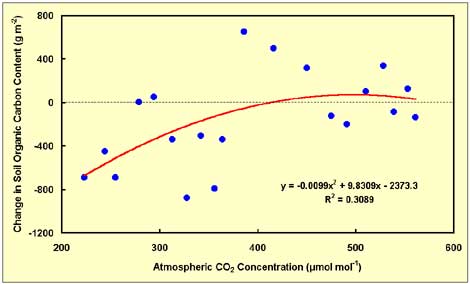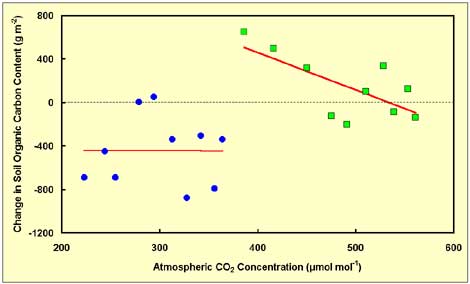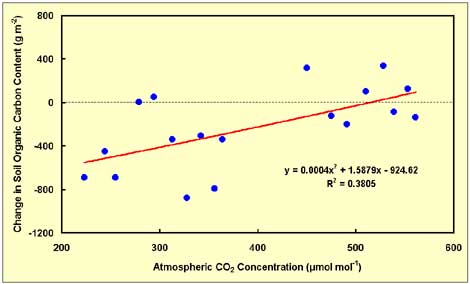Volume 5, Number 21: 22 May 2002
A Duke University press release dated 15 May 2002 heralds the "end of [the] 'free ride' on ecosystem CO2 absorption." The free ride to which the document refers is the historical and still-ongoing increase in the capacity of the world's soils to store carbon as a consequence of the historical and still-ongoing increase in the growth of the planet's vegetation that has been driven by the historical and still-ongoing increase in the air's CO2 content that has been associated with the demise of the last great ice age and the inception and progression of the Industrial Revolution.
Stimulated by the gradually intensifying aerial fertilization effect of this rise in the atmosphere's CO2 concentration, earth's plants extracted ever increasing amounts of the CO2 that went into the air during this long period of time and sequestered its carbon in their tissues and the soils in which they grew. Consequently, were it not for this increasingly voracious appetite of the globe's plants for carbon dioxide - the more CO2 there is in the air, the more of it they absorb - the air's CO2 content would have risen much higher than it actually has, and it currently would be rising nearly twice as fast as it actually is.
The Duke University press release appears to readily accept all of this past good news. With respect to the future, however, it has nothing encouraging to say. In fact, it states that the CO2-enhanced sequestration of carbon will shortly come to an end, and that we will therefore soon be looking at yearly atmospheric CO2 increases "that are double what they are now."
The basis for this pessimistic and, we believe, erroneous contention is the recently published paper of Gill et al. (2002), wherein the authors describe their multi-year study of carbon sequestration in the soils of several portions of a Texas grassland ecosystem that were maintained under a variety of atmospheric CO2 concentrations, ranging from just over 220 to just over 560 µmol CO2 per mol air (µmol mol-1). The Duke University press release refers to this experiment as a "precise ecosystem study," and in nearly all respects, that description is correct. In the case of the most crucial measurement of all (soil organic carbon content), however, the word precise is totally inappropriate, if not outright wrong; for it is notoriously difficult to accurately measure the relatively small changes in soil organic carbon content that occur over periods of a few short years, which in this specific instance numbered but three.
Consider, for example, the data of Figure 1, which we have carefully extracted from a figure in the Gill et al. paper. The scatter in the data is tremendous, especially in the mid-CO2-range, where the difference between the high and low extremes of the three-year soil organic carbon content change is considerably greater than the difference between what would be calculated from the beginning and end points of any reasonable trend line that might be fit to the data. So what did Gill et al. do to conclude - from these highly imprecise data - that the ability of earth's ecosystems to continue to enhance their capacity to sequester carbon in response to future increases in the air's CO2 content would soon be coming to an end?

Figure 1. The entire suite of 1997-2000 changes in the organic carbon content of the top 15 cm of soil plotted against atmospheric CO2 concentration. From Gill et al. (2002).
The group's fatal misstep was trying to coax more out of their data than could realistically be delivered. Accepting all of their widely-dispersed data points as equally valid, Gill et al. fit a second-order polynomial to them, as shown in Figure 2. This functional representation - which rises rapidly from the lowest CO2 concentration employed in the study to a concentration of approximately 400 µmol mol-1, but then levels out - serves as the basis for their contention that the CO2-induced stimulation of carbon sequestration that is evident over the first half of the CO2 concentration range essentially disappears above an atmospheric CO2 concentration of 400 µmol mol-1. That's what their representation of the data implies, alright. But is this representation correct?

Figure 2. The entire suite of 1997-2000 changes in the organic carbon content of the top 15 cm of soil plotted against atmospheric CO2 concentration, together with the trend line fit to the data by Gill et al.
In broaching this question, we begin as Gill et al. did in another place in their paper and divide the data of Figure 2 into two groups: a sub-ambient-CO2 group (comprised of the 10 data points with the lowest atmospheric CO2 concentrations) and a super-ambient-CO2 group (comprised of the 10 points with the highest atmospheric CO2 concentrations). But instead of calculating the mean three-year change in the soil organic carbon content of each of these groups, as they did, we derive best-fit linear regressions for each group, as shown in Figure 3.

Figure 3. The sub-ambient-CO2 and super-ambient-CO2 changes in the organic carbon content of the top 15 cm of soil plotted against atmospheric CO2 concentration, together with the linear regression lines we have fit to the two groups of data.
In viewing these results, it can be seen that the sub-ambient-CO2 data - by themselves - exhibit absolutely no trend in carbon sequestration with increasing atmospheric CO2 content (because, of course, of their high imprecision); yet this is the CO2 range over which Gill et al. claim the strongest - actually, the only - positive carbon sequestration response to atmospheric CO2 enrichment. In point of fact, however, the only way they can support this contention is via the help they receive from their super-ambient-CO2 data; and it is the uncritical way in which they used these data that led them to draw their unwarranted conclusion about rising CO2 concentrations having little effect upon soil carbon sequestration above a concentration of 400 µmol mol-1, as we will now demonstrate.
First of all, it is important to note the great discontinuity that exists between the two data sets of Figure 3, i.e., the great jump in the change in soil organic carbon content that occurs where the relationship describing the first data set ends and the relationship describing the second data set begins. One way to resolve this problem - and, hopefully, make the discontinuity disappear - would be to acquire many more data points across the entire range of atmospheric CO2 concentration that was investigated. Unfortunately, the data displayed are all the data that exist. Hence, a different approach must be employed; and that approach is to use less data, specifically, to delete from the highly-variable population of imprecise data points a small number of the most aberrant points.
So, which are "the most aberrant points"? Logic would suggest they are the ones that make the biggest contribution to the patently unreal discontinuity between the two groups of data. Can you guess which ones they are? That's right. They are the first two (lowest-CO2-value) data points of the super-ambient-CO2 group. Removing those two data points does more to make the two groups of data compatible with each other than does the removal of any other two data points of either group.
When these highly aberrant data points are thus deleted, as shown in Figure 4, the data that remain are best described by a simple straight line; and that straight line implies that there is no detectable change in the CO2-induced stimulation of soil carbon sequestration over the entire range of atmospheric CO2 concentration investigated by Gill et al. And that is the only conclusion that can validly be drawn from their data.

Figure 4. The changes in the organic carbon content of the top 15 cm of soil plotted against atmospheric CO2 concentration, with the two most aberrant of the imprecise data points removed, together with the linear regression we have fit to the data.
To emphasize this point, we have also fit a second-order polynomial (the functional form preferred by Gill et al.) to the data of Figure 4, obtaining the result depicted in Figure 5. Interestingly, although the result is indeed a curve, one really has to squint to see it. In fact, the curvature of the line is so slight that its graphical representation in Figure 5 is virtually indistinguishable from the straight line of Figure 4; and it possesses essentially the same R2 value. Hence, and once again, it is abundantly clear there is no defensible basis for claiming anything about the response of soil carbon sequestration in this Texas grassland ecosystem to the range of atmospheric CO2 enrichment employed in this study beyond what is suggested by the results of Figures 4 and 5, i.e., that the response is linear.

Figure 5. The changes in the organic carbon content of the top 15 cm of soil plotted against atmospheric CO2 concentration, with the two most aberrant of the imprecise data points removed, together with the second-order polynomial we have fit to the data.
The end result of this more realistic and critical treatment of the data - wherein we identify and discard the two most aberrant data points (10% of the original 20) - contradicts Gill et al.'s conclusion that the sequestration of carbon in soils is more responsive to atmospheric CO2 increases at the low end of the CO2 concentration range they investigated than at the high end of that range. In light of the gradual weakening of the aerial fertilization effect of atmospheric CO2 enrichment that is often observed in experiments as the air's CO2 content is sequentially elevated, however, one might logically have expected to see something along the lines of what Gill et al. wrongly concluded, although of a much more muted nature. Nevertheless, such was not observed. Why?
Part of the answer to this question undoubtedly resides in the nature of the photosynthetic responses of the grassland plants to atmospheric CO2 enrichment. It is interesting to note, for example, that the CO2-induced stimulation of the maximum photosynthetic rates of the plants did not taper off, as might have been expected, as the air's CO2 content rose, even at the highest CO2 concentration investigated. Rather, the photosynthetic response was linear, just like that of the change in soil organic carbon content. What is even more interesting - even fascinating - in this regard, is that the linear responses were maintained in the face of what Gill et al. say was a "threefold decrease in nitrogen availability" as the air's CO2 content went from its lowest to highest level.
In light of these striking experimental observations, we fiercely disagree with Gill et al.'s conclusion that the ability of soils to continue as carbon sinks will be severely limited in the near future by impending nutrient limitations. Indeed, their own data, when properly analyzed, indicate that even with their "threefold decrease" in soil nitrogen availability, the soil of the grassland they studied continued to sequester ever greater amounts of carbon as the air's CO2 content continued to rise to close to 200 µmol mol-1 above the atmosphere's current CO2 concentration.
How sad it is, therefore, that Duke University ecologist Robert B. Jackson, on the basis of the Gill et al. paper of which he was a co-author, would publicly state, as reported in the Duke University press release, that "the current lack of interest by the United States in participating in the Kyoto accords is especially unfortunate." In point of fact, if there is anything unfortunate here, it is that so many people have been so egregiously mislead by Jackson's unsubstantiated declaration; for when properly considered, the data of Gill et al. actually imply that earth's vegetation will yearly sequester ever more carbon as the CO2 concentration of the atmosphere continues to rise, thereby exerting an increasingly more powerful brake on the rate of increase in the air's CO2 content and reducing the potential for deleterious global warming.
So climb aboard the fossil-fueled biospheric train, folks, the ride is still free!
|
Dr. Sherwood B. Idso President |
Dr. Keith E. Idso Vice President |
Reference
Gill, R.A., Polley, H.W., Johnson, H.B., Anderson, L.J., Maherali, H. and Jackson, R.B. 2002. Nonlinear grassland responses to past and future atmospheric CO2. Nature 417: 279-282.




